During the Baroque period the idea of the modern orchestra was born, along with opera, the concerto, sonata, and cantata. Composers and performers used more elaborate musical ornamentation, made changes in musical notation, and developed new instrumental playing techniques. Choral music was no longer king, as composers turned to composing instrumental works for various ensembles. “Classical” music gradually began to work its way into society, being played outdoors at dinner parties and special functions, or as a spectacle in the form of opera.
The word “baroque” comes from the Portuguese word barroco meaning misshapen pearl, a negative description of the ornate and heavily ornamented music of this period.
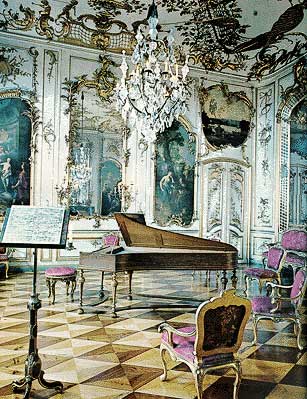
Baroque Music Room
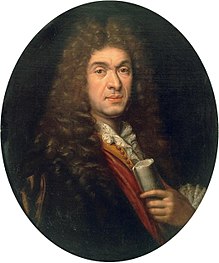
Jean-Baptiste Lully (1632-1687)
Lully was an Italian-born French composer, instrumentalist, and dancer. His father, of peasant stock, married a miller’s daughter and took over the business. The boy probably received his musical education from Franciscan friars in Florence. He left Italy for Paris in 1646 to serve as an Italian tutor to Anne-Marie-Louise d’Orleans, a cousin of Louis XIV. He entered the service of Louis XIV in 1652, when the Sun King was 14 years old. In 1653 the king appointed him composer of instrumental music, and from that post he began a steady ascent to the top of French musical life.
Lully achieved an extremely elegant yet lively fusion of ballet, choral music, and solo singing highlighted by richly varied airs and duets, expressively charged recitatives, and vibrant orchestral colorism. He died a wealthy man, able to command the highest ticket prices in Paris for the splendid entertainments he put on.
Here are examples of music from three of his operas. Atys is presented in the style of the 17th century French court.
Ballet Royal d’Alcidiane: Ouverture/La Petite Chaconne (1658)
Armide, LWV 71: Passacaille. Les Plaisirs ont choisi pour asile (1686)
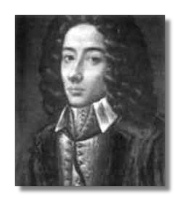
Dietrich Buxtehude (1637-1707)
In contrast to many composers of the day, Buxtehude was not a creature of court, but instead was church musician, holding the posts of organist and Werkmeister at the St. Mary’s church in Lübeck. His duties as Werkmeister involved acting as the secretary, treasurer, and business manager of the church, while his position as organist included playing for all the main services, sometimes in collaboration with other instrumentalists or vocalists.
In Lübeck he rose to such fame that musicians from northern Germany came to the city to meet the composer and attend his concerts. He was visited by George Frideric Handel in 1703 and by Johann Sebastian Bach in 1705. According to legend Bach walked more than 200 miles to meet him. Bach did study with Buxtehude for several months in 1705 and 1706. Both composers wanted to follow Buxtehude at St. Mary’s, but neither one wanted to marry his daughter (a condition for the position).
Praludium in G minor, BuxWV149
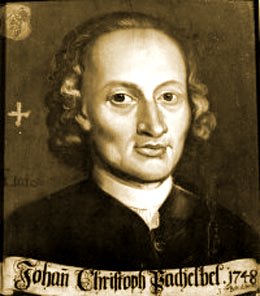
Johann Pachelbel (1653-1706)
Pachelbel was born in Nuremberg, Germany to a middle-class family. He was very talented musically and academically, but he wasn’t considered a child prodigy. He is known for his works for organ and was one of the great organ masters of the generation before Johann Sebastian Bach. Though a busy organist throughout his working life, Pachelbel was a remarkably prolific composer. He wrote for the organ, harpsichord, chamber ensembles and various vocal media.
Pachelbel moved around quite a bit during his life. He lived in Vienna, Austria for a time, and continued composing and playing the organ there. He later moved to Eisenach, Germany and became good friends with several members of the Bach family. In fact, Johann Christoff Bach was Pachelbel’s student and later tutored his younger brother, Johann Sebastian Bach
The Hexachordum Apollinis (1699)
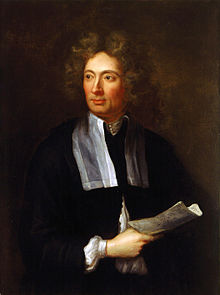
Arcangelo Corelli (1563-1713)
The Italian composer and violinist Arcangelo Corelli exercised a wide influence on his contemporaries and on the succeeding generation of composers. Born a full generation before Bach or Handel, he studied in Bologna, a distinguished musical center, then established himself in Rome in the 1670s.
By 1679, Corelli had entered the service of Queen Christina of Sweden, who had taken up residence in Rome in 1655, after her abdication the year before. Thanks to his musical achievements and growing international reputation he found no trouble in obtaining the support of a succession of influential patrons.
History has remembered him with such titles as “Founder of Modern Violin Technique,” and the “World’s First Great Violinist.” Numbered among his students is Antonio Vivaldi, who later composed hundreds of works based on the principles in Corelli’s trio sonatas and concerti.
Trio Sonata in D Minor, Op. 3, No. 5 (1689)
La Folia Variations
The theme for La Folia, was not in fact written by Corelli. It was rather a traditional Iberian folk-dance melody. Many other composers made use of this theme including Bach, Vivaldi, Liszt and Rachmaninoff.
Variations of a Theme of Corelli
Composed in 1931 by Sergei Rachmaninoff. This was his last original work for solo piano.
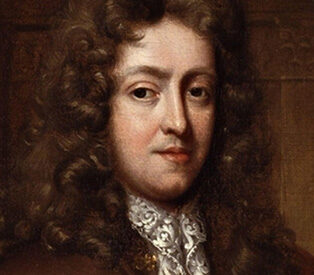
Henry Purcell (1659-1695)
English-born Henry Purcell was the finest and most original composer of his day. Though he was to live a very short life, he was able to enjoy and make full use of the renewed flowering of music after the Restoration of the Monarchy.
As the son of a musician at Court, a chorister at the Chapel Royal, and the holder of continuing royal appointments until his death, Purcell worked in Westminster for three different Kings over twenty-five years.
In addition to his royal duties Purcell also devoted much of his talent to writing operas, or rather musical dramas, and incidental stage music. The writing of incidental theater music seems not to have been regarded by Purcell as embarrassing or beneath his dignity as Organist of Westminster Abbey. He was in the very midst of a tradition that not only permitted but actually encouraged well-known church musicians to provide lighter music for the theatre and opera, and this was an accepted practice in the great continental cities as well as in London.
Most of Purcell’s theatre music was written between 1690 and 1695 (the year of his death), and within that relatively brief period he supplied music for more than forty plays.
Chaconne G Minor, Z. 730 (c. 1680)
The Fairy Queen, Z. 629 (1692)
Dido and Aeneas: When I am Laid in Earth (c. 1683-1688)
This story recounts the love of Dido, Queen of Carthage, for the Trojan hero Aeneas, and her despair when he abandons her. A monumental work in Baroque opera, Dido and Aeneas is remembered as one of Purcell’s foremost theatrical works. It was also Purcell’s only true opera, as well as his only all-sung dramatic work.
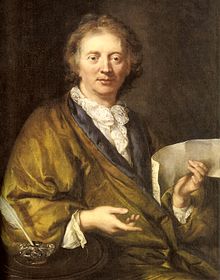
Francois Couperin (1668-1733)
Although François Couperin was only 10 years old when his father, Charles Couperin, died, the wardens of the Church of Saint-Gervais in Paris reserved his father’s office of organist for him until he was 18. The boy took over the post before his 18th birthday. François is known above all for his harpsichord music. Between 1713 and 1730 he published four books of suites for harpsichord. The movements of these suites have highly ornamented melodies and complex accompaniments. Johann Sebastian Bach knew Couperin’s work and copied it.
Les Barricades Mysterieuses (1717)
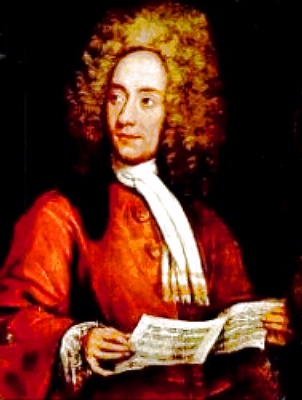
Tommaso Albinoni (1671-1750)
Tomaso Giovanni Albinoni was born in Venice on June 8, 1671, eldest son of a wealthy paper merchant. At an early age he became proficient as a singer and, more notably, as a violinist, though not being a member of the performers’ guild he was unable to play publicly so he turned his hand to composition.
Until his father’s death in 1709, he was able to cultivate music more for pleasure than for profit, referring to himself as “Dilettante Veneto” – a term which in 18th century Italy was totally devoid of unfavorable connotations.
Under the terms of his father’s will he was relieved of the duty (which he would normally have assumed as eldest son) to take charge of the family business, this task being given to his younger brothers. Henceforth he was to be a full-time musician, a prolific composer who according to one report, also ran a successful academy of singing.
Oboe Concerto in D Minor, Op. 9, No.2 – Adagio (1722)
Albinoni was particularly fond of the oboe, a relatively new introduction in Italy, and is credited with being the first Italian to compose oboe concertos.
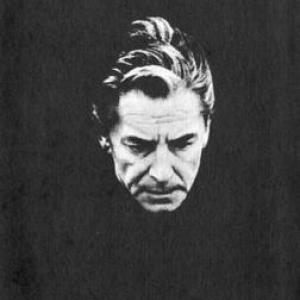
Albinoni’s famous Adagio was actually composed by the Italian musicologist Remo Giazotto in 1945. This is certainly surprising because, after all, the famous Adagio in G minor is not only one of the best-known pieces of classical music but also one of the most popular among music lovers with a closely linked name of title and author: “Albinoni’s Adagio”. It is ironic, therefore, that in reality the work is not by that baroque composer, but by one of his biographers who lived two centuries later.
Much of Albinoni’s music was lost in the bombing of Dresden during World War II, but Giazotto claimed to have composed this piece based on a fragment of a sonata the he found in the ruins of the library. However, no one else has ever seen this fragment and today all experts consider this a composition by Giazotto himself.; the only one he did in his lifetime. He died in 1998, taking the secret of why he did this with him to his grave.